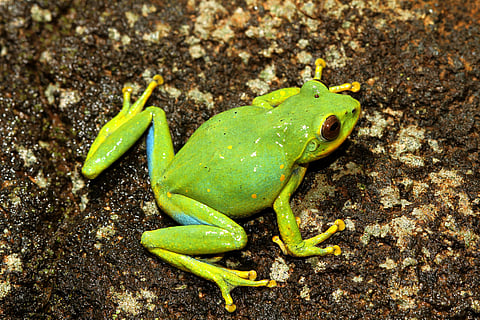

A global study has found that 788 amphibian species have declined in conservation status in the last 40 years, compared with just 121 that improved.
Habitat loss, agriculture, climate change and disease are the biggest threats, affecting thousands of species.
Amphibians make up 25.2% of all threatened vertebrates yet receive only 3.4% of global conservation funding.
India, Costa Rica and Malaysia recorded notable conservation gains, with several species downlisted after targeted interventions.
A new analysis has revealed that amphibian populations have deteriorated sharply worldwide, with more than six times as many species declining as improving since 1980. A total of 788 amphibian species have declined in conservation status over the past four decades, while only 121 have shown improvement, according to a new study.
Between 1980 and 2004, the conservation status of 482 amphibian species deteriorated, with a further 306 species declining between 2004 and 2022. By contrast, assessments by the International Union for the Conservation of Nature (IUCN) show that only 35 species improved in the first period and 86 in the second.
The findings, published in the journal Nature Reviews Biodiversity, warn that amphibians are experiencing a biodiversity crisis more severe than any other vertebrate group, yet conservation and research investment remains disproportionately low.
According to the study, habitat loss and degradation threaten the largest number of amphibians, affecting 2,684 species. Agriculture impacts 77 per cent of species, timber and plant harvesting 53 per cent, and infrastructure development 40 per cent.
Climate change and disease are the next most significant pressures, each affecting 29 per cent of threatened species. Overexploitation for food and the pet trade impacts a further 8 per cent.
Amphibians are the most threatened vertebrate group globally, with 41 per cent of species classified as threatened. They account for 25.2 per cent of all threatened vertebrates on the IUCN Red List but receive only 3.4 per cent of vertebrate conservation funding.
“With 37 amphibian species already declared Extinct (EX) and another 185 species considered Critically Endangered (Possibly Extinct), (CR(PE)), their survival demands urgent action,” the authors wrote in the paper.
Climate change and infectious diseases together affect nearly 29 per cent of threatened amphibians — 845 species impacted by climate change and 880 by disease. The latter remains the leading factor pushing species into the highest extinction-risk categories in 2022.
The decline in species and their abundance also undermines ecological functions. For example, Nanorana vicina, a frog endemic to the Hindukush-Himalayan region, is part of the diet of the leopard cat (Prionailurus bengalensis), underscoring the importance of amphibians within local food webs.
Amphibians play crucial roles as both predators and prey, facilitate nutrient cycling between aquatic and terrestrial ecosystems, and enhance soil aeration and productivity. Their decline can trigger cascading biodiversity losses, disrupting predators and destabilising ecosystems. They also provide services such as agricultural pest control and disease regulation.
In Brazil alone, pest control by anurans contributes an estimated $1.18 billion in successful crop harvests, with amphibians consuming up to 300 million crop pests each year.
The authors note that conservation interventions have yielded improvements in some regions. Effective habitat protection, removal of invasive species and improved management practices have led to downlistings — reductions in extinction risk — for several species.
“For example, removing invasive fish has enabled the survival of the Critically Endangered spotted tree-frog (Litoria spenceri), and the recovery of the Vulnerable Iberian frog (Rana iberica), despite secondary threats,” the study found. More than half (51 per cent) of all downlistings since 1980 were linked to such measures.
India is among the countries, along with Costa Rica and Malaysia, that have recorded significant improvements in amphibian conservation status since 1980. The successful protection of Hoplobatrachus species following their inclusion in the global conservation agreement Convention on International Trade in Endangered Species of Wild Fauna and Flora Appendix II contributed to their recovery in India.
Several Western Ghats species have also improved in status, including Ghatophryne rubigina, Raorchestes honnametti, Raorchestes indigo, Raorchestes kakachi, Raorchestes silentvalley, Raorchestes uthamani, Nyctibatrachus vasanthi and Micrixalus kodayari.
The authors called for stronger, coordinated efforts to halt amphibian extinctions, including better implementation of global conservation frameworks such as the Threatened Amphibian Landscapes initiative and the Kunming-Montreal Global Biodiversity Framework.
They stress the need for expanded capacity, improved funding mechanisms and the adoption of emerging technologies, including environmental DNA, remote sensing and genetic interventions, to safeguard the future of amphibian biodiversity.